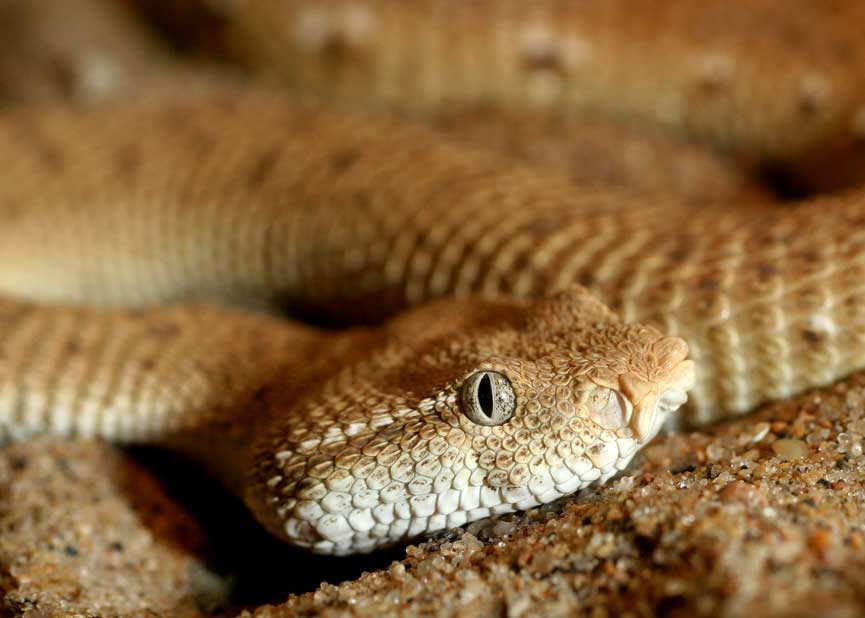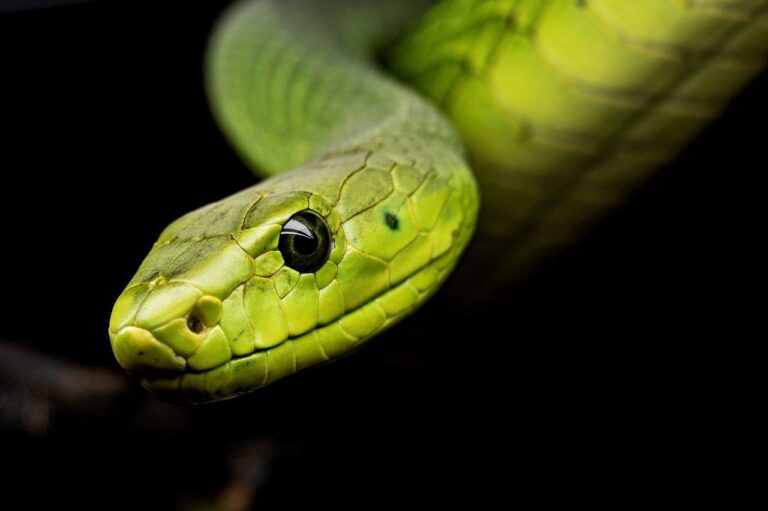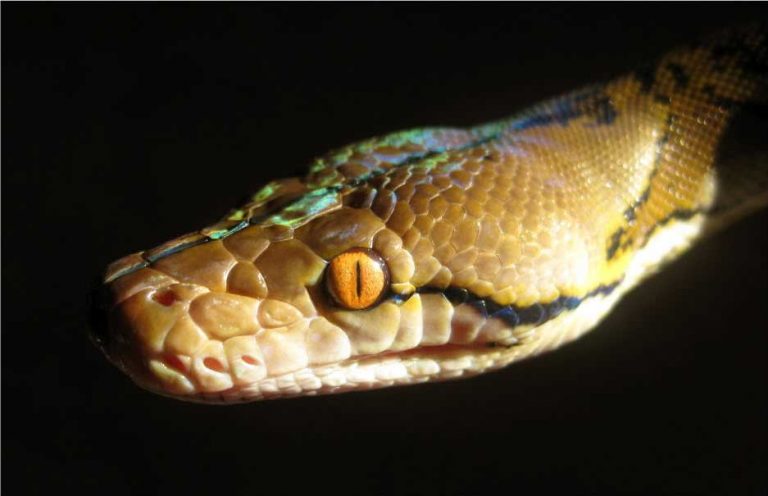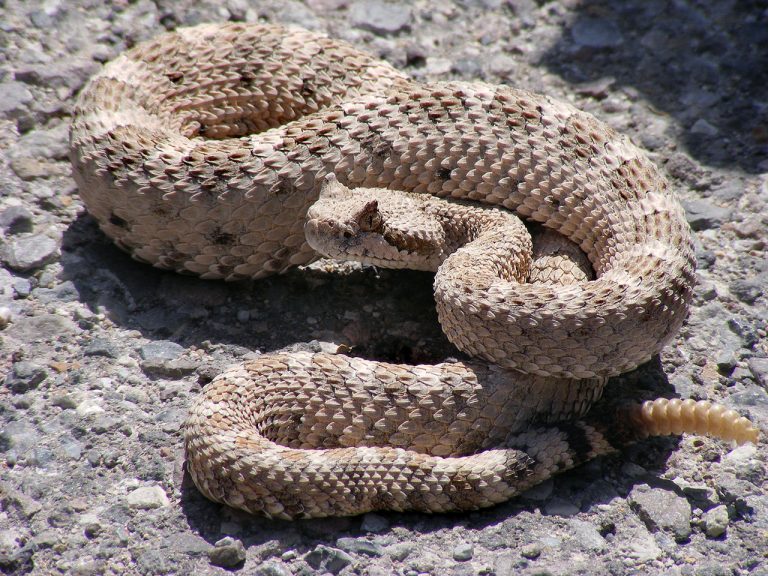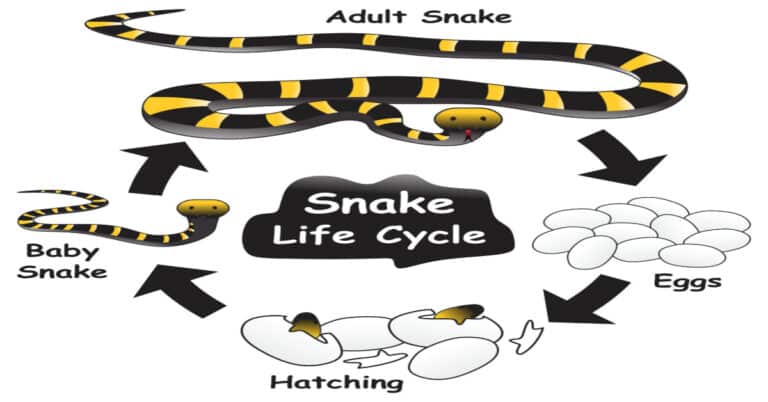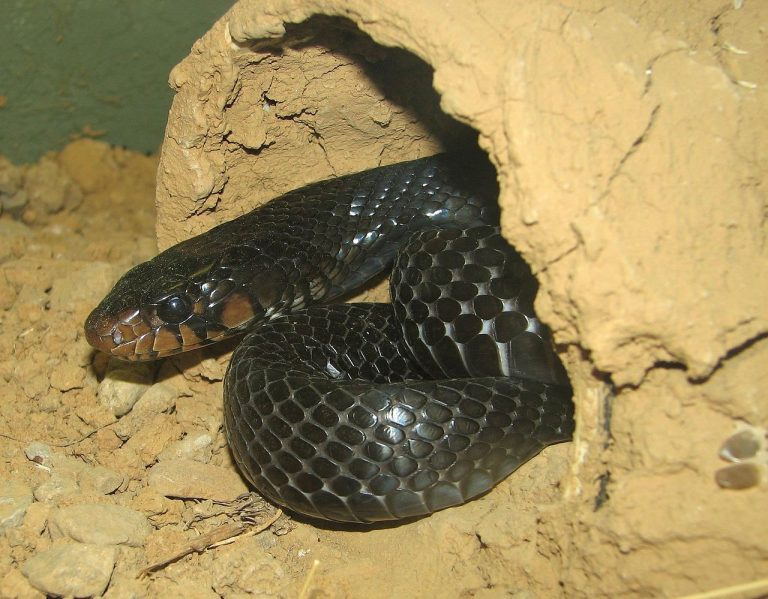Types of Snakes: Viperidae (Vipers)
Scientific Classification
| Kingdom: | Animalia |
| Phylum: | Chordata |
| Subphylum: | Vertebrata |
| Class: | Reptilia |
| Order: | Squamata |
| Suborder: | Serpentes |
| Family: | Viperidae |
Viperidae is another prominent family of poisonous snakes. You can identify the snakes in the ‘Viper Family’ by their hinged, long, hollow fangs. Quite distinct from the Elapids, with their fixed fangs, Vipers, have fangs that they can retract and extend. When passive, the fangs remain folded at the back against the roof of its mouth. When the mouth opens, the fangs extend and get into biting mode. The common vipers are Rattlesnakes, Bushmasters, Copperheads, Water Moccasins, Russell’s Viper, Gaboon Vipers, Saw-scaled Vipers, Temple Vipers, and Rhinoceros Vipers.
The Russell’s Viper – Daboia Russelii
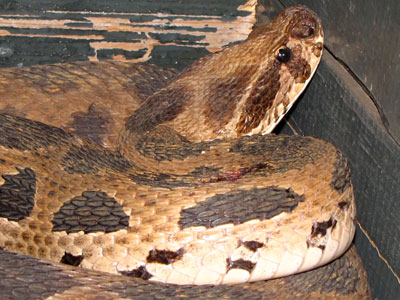
Daboia is a monotypic genus of venomous Old World viper. The single species, D. Russelii, is found in Asia throughout the Indian subcontinent, much of Southeast Asia, southern China and Taiwan. Apart from being a member of the big four snakes in India, Daboia is also one of the species responsible for causing the most snakebite incidents and deaths among all venomous snakes on account of many factors, such as their wide distribution and frequent occurrence in highly populated areas. Daboia is commonly known as Russell’s viper and chain viper, This snake can grow to a maximum total length (body + tail) of 166 cm (5.5 ft) and averages about 120 cm (4 ft) on mainland Asian populations. It has a flattened triangular head that is distinct from its neck. The snout is blunt, rounded and raised.
The Saw Scaled Viper – Echis Carinatus
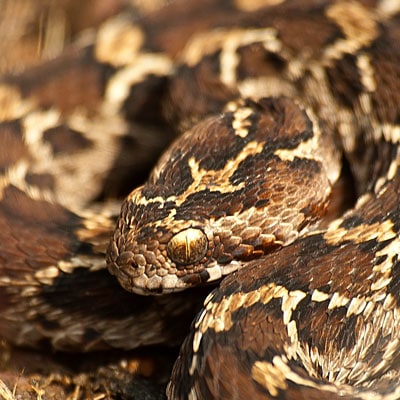
Echis are a genus of venomous vipers found in the dry regions of Africa, the Middle East, Pakistan, India, and Sri Lanka. They have a characteristic threat display, rubbing sections of their body together to produce a “sizzling” warning sound. The name Echis is a Greek word for “viper. Their common name is “saw-scaled vipers” and they include some of the species responsible for causing the most snakebite cases and deaths in the world. Saw-scaled vipers are relatively small snakes, the largest species staying slightly below 90 cm (35 in) in total length (body+ tail), and the smallest being around 30 cm (12 in) in total length. The head is relatively small and is short, wide, pear-shaped and distinct from the neck. The snout is short and rounded, while the eyes are relatively large and the body is moderately slender and cylindrical.
Uzungwe Viper – Adenorhinos Barbouri
Uzungwe Vipers belong to the species Adenorhinos Barbouri. Adenorhinos is the name of the monotypic genus created for these venomous vipers. This is a very rare species confined to South Tanzania’s Uzungwe and Ukinga mountains. Though rare, they are known by a host of names which include worm-eating viper, and short headed viper (barbouri). The maximum length is 40 centimeters, inclusive of tail. The triangular, broad head is distinct from the neck and is covered by broad scales. The scales are strongly keeled (with raised ridges), and smooth. These snakes have very prominent eyes. They have short, rounded snouts. We know little about the composition and toxicity of the venom as well as the effects their bites. They are normally brown or blackish brown with two dorsal zigzag stripes.
Bush Viper – Atheris Squamigera
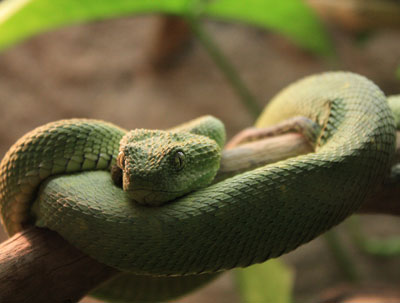
Atheris is the genus of poisonous vipers, commonly called Bush Vipers. They belong to the subfamily vipernae. They are endemic to sub-Saharan regions of Africa. They show marked similarities to pit vipers which are basically arboreal (they spend most of their time high up in the trees) in Asia and South America. Bush vipers are comparatively small in size. The maximum length is 40 centimeters for katangensis species and 78 centimeters for species squamigera. All species in the genus, Atherishave triangular, broad heads, distinct from neck. Imbricate or smooth scales cover the crown. The species have broad snouts. They have comparatively large eyes with elliptical pupils.
McMahon’s Vipers – Eristicophis Macmahonii
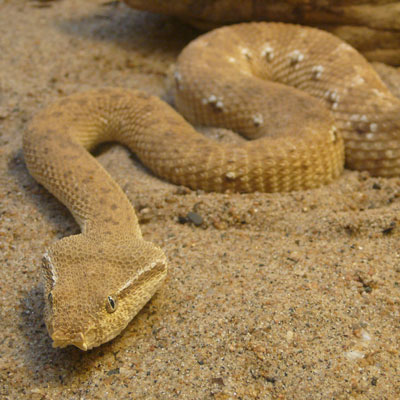
McMahon’s vipers belong to the monotypic genus Eristicophis and the subfamily vipernae. The species McMahoni is confined or endemic to the desert areas of Baluchistan, bordering Afghanistan, Pakistan and Iran.
McMahoni is a comparatively small species with the total body length (inclusive of tail) seldom exceeding 1 Meter. The females are comparatively larger than the males. The heads are flat, broad, large and wedge shaped, distinct from the neck. The snout is short and broad. Small scales cover the crown.
Palearctic Vipers – Macrovipera
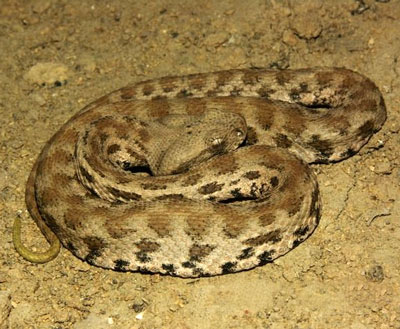
These vipers belong to the genus Macrovipera. These snakes spread along the steppes and semi desert areas of North America, the Milos Archipelago, situated in the Aegean sea and the middle east. These snakes contribute to a considerable number of snake bite fatalities in west Asia and Africa. These snakes are notorious for their ill temper and they can inject a large amount of venom in a single bite. They are therefore considered very dangerous. All the snakes exceed 1.5 meters in overall body length. The flat, broad head is distinct from the neck. Small, irregular, keeled scales cover the dorsal side.
Kenya Mountain Viper – Montatheris
Mountain Vipers of Kenya belong to the subfamily viperinae of the monotypic genus Montatheris. These vipers are known by a lot of names that include Hind’s Viper, Montane Viper (Kenya) and Mountain Viper (Kenya). These terrestrial vipers are confined to Kenya. These are basically small snakes with an overall average body length of 20 to 30 centimeters. The maximum length they attain is around 35 cms. It has an elongated head that is not very distinct from the neck. The eyes are small. They have strongly keeled (ridged) dorsal scales.
Lowland Viper – Proatheris Superciliaris
Lowland vipers belong to the species Proatheris superciliaris of the monotypic genus proatheris of the subfamily viperinae. These are terrestrial species, meaning that they prefer to be on the ground all the time, they are confined to the eastern parts of Africa. These snakes are very small. They average 40 to 59 cms in length. The maximum overall length can be 61 centimeters. The females are relatively larger than males. The head of the snake has a rather elongated appearance.
False Horned Viper – Pseudocerastes
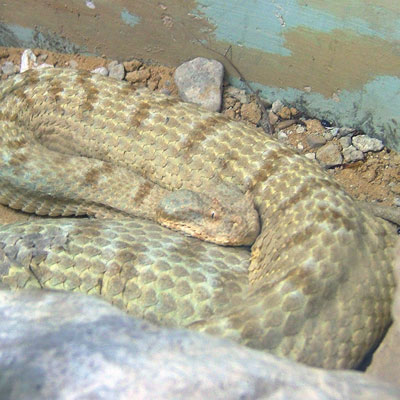
False horned vipers belong to the genus Pseudocerastes of venomous vipers that are endemic to Asia and the Middle East.
The average overall adult length varies between 40 to 70 centimeters. The maximum total length can be 108 cms, Females are larger than the males. These snakes do attain considerable in relation to the size. Some of the specimens exceed 500 grams.
The flat, broad head is distinct from the neck. Small, imbricate (smooth) scales cover the head. The snake posses a short and rounded snout. The nostrils have valves and they are positioned dorsolaterally.
Copperheads – Agkistrodon Contortrix
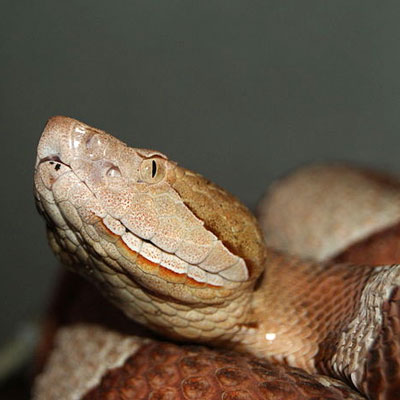
This species of venomous snake is confined to North America. They are members of the pit viper (Crotalinae) subfamily. The copperhead is the common name of the species. Adult Copperheads usually grow 50-95 centimeters in length. Some may grow beyond 1 meter. Males are larger than the females. Even though these snakes are poisonous, they are not at all aggressive and their bites are seldom fatal.
Water Moccasin – Agkistrodon Piscivorus
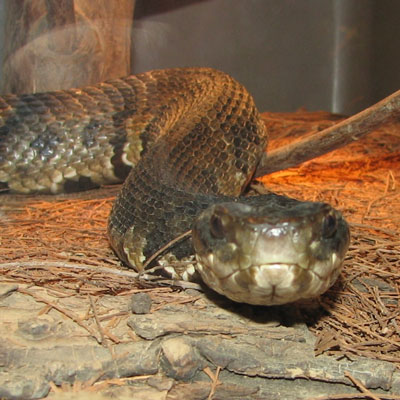
Water Moccasins are venomous snakes. They are a species of the Pit Viper that you can find in the southeastern parts of the United States. The adult snakes are large and they are capable of bytes that can prove to be very painful and potentially fatal. These snakes are the largest species in the genus Agkistrodon. The adults usually exceed 80 centimeters in length. We can find the species distributed in eastern USA in Delmarva Peninsula, to the south through the Florida peninsula, west to Arkansas and to central Texas. Water Moccasins are more venomous than Copperheads. The venom is loaded with tissue destructive enzymes.
Red Diamond Rattlesnake – Crotalus Ruber
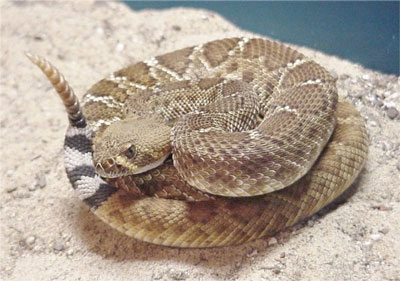
Red Diamonds are rattlesnakes, which belong to the poisonous Pit Viper species that you can find in California in the U S and Mexico’s Baja California. This is a moderately large sized species. They usually exceed 100 centimeters length on the mainland. Larger species may exceed the length of 140 centimeters. These snakes are mild natured. They possess the least potent of rattlesnake venoms.
Rough-scaled Bush Viper – Atheris Hispida
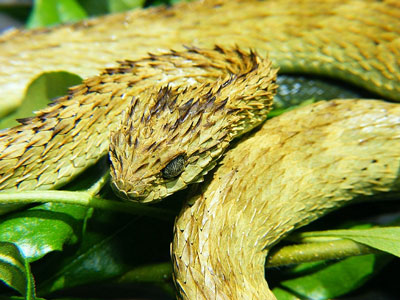
Bush Vipers are a poisonous viper species endemic or confined to Central Africa. The snake has very keeled dorsal scales, presenting it with a bristly appearance. The males grow to t73 centimeters length at the most with the tail accounting for 15 centimeters. Females grow to the maximum length of 58 centimeters. Their venom is mainly neurotoxic. There is not much more we know besides that.
Common European Adder – Vipera Berus
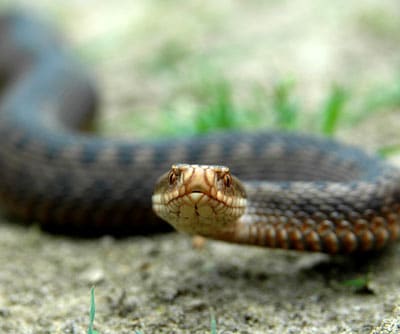
European adders or Vipers are an extremely widespread poisonous species that is very widespread. We can find these vipers throughout the major portion of western Europe and so far as West Asia. They have a number of Common names. They include, Common adder and the Common Viper. They are usually thick bodied. The adult vipers usually grow to 60 centimeters, tail included. The average length is 55 centimeters. The size varies according to the region. The largest of these Vipers, you can see in Scandinavia, reaching 90 centimeters. Human expansion has been rapid throughout the range of these species and snake bites are rather common.
Puff Adder – Bitis Arietans
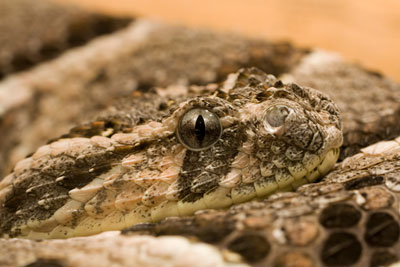
Puff Adders are a poisonous viper species. You can find them in savannahs and grasslands, ranging from Morocco and western parts of Arabia and throughout Africa, except the Sahara region and the rain forests. Puff Adders account for the most snakebite deaths in Africa. The widespread distribution of the species and the occurrence in densely populated areas are responsible. The average size of the Puff Adder is around 1 meter, including tail and they appear very stout in build. There have been reports of large specimens with a length of 190 centimeters, with a girth of 40 centimeters and weighing over six kilos.
The Horned Adder – Bitis Caudalis
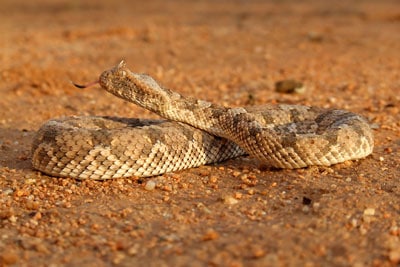
The horned Adder is a poisonous species we can find in the arid regions of Southwest Africa. We can easily distinguish the snake by the presence of single scales over each eye that resemble horns. They are stout little vipers with an average length of 30 to 40 centimeters, inclusive of tail. We can assume that bites from this species are rare in the absence of further data.
Western Diamondback Rattlesnake – Crotalus Atrox
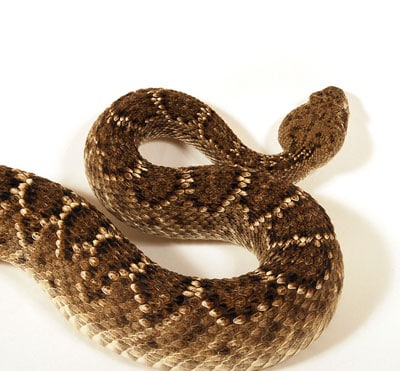
Western Diamondbacks are venomous Rattlesnakes that we can find in the United States and Mexico. These snakes account for the majority Of Snakebite deaths in northern Mexico and the second greatest number in the U S A. Adults usually grow to a length of 120 centimeters. Some may grow over 150 centimeters. As in the case of most pit vipers, the venom comprises of proteolytic enzymes.
Eastern Diamondback Rattlesnake – Crotalus Adamanteus
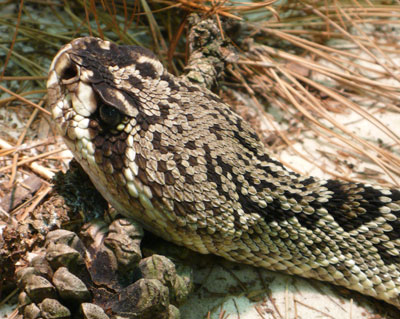
Eastern Diamondbacks are Rattlesnakes from the venomous Pit Viper sub-family. It is the heaviest poisonous snake and the largest rattlesnake in America. The heaviest specimens measure around 7-8 ft in length and weigh over 15 kilos. The Eastern Rattlesnake has the dubious distinction of being the most dangerous poisonous snake in North America.
Timber Rattlesnake – Crotalus Horridus
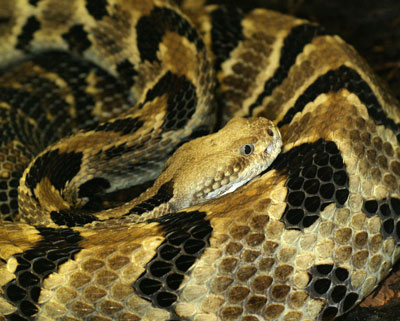
Timber rattlesnakes are a species of venomous Pit Vipers that we can find in the eastern United States. We know them by many names including Banded rattlesnakes and Canebrake rattle snakes. Timber Rattlers have wide heads and narrow necks. This is a Characteristic feature of all poisonous snakes. These Rattlers are the largest rattlesnakes in Texas and the second largest in the United States. Adult timber snakes grow to a length of 36 to 40 inches and weigh 1.3 to 7 pounds.
Black-tailed Rattlesnake – Crotalus Molossus
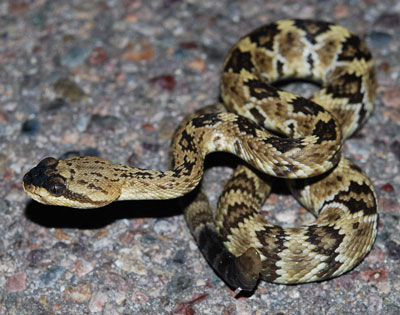
Black-tailed rattlesnakes are poisonous pit viper species that you can find in southwestern united states and Mexico. They average in length from 76 to 107 centimeters.
Persian Horned Viper – Persicus
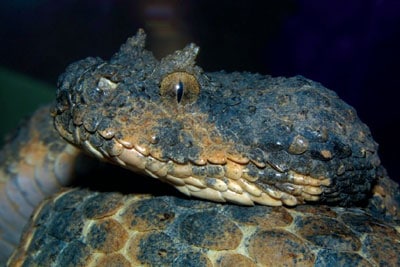
Persian Horned Vipers Belong to the genus Pseudocerastes. They are venomous vipers, endemic or confined to the middle east and Asia. Many call them the false horned vipers because of their hornlike structures over the eyes that are actually made up of a number of small scales. Adults average 40 to 70 centimeters in overall length. The maximum total length can be 108 centimeters. The venom can cause hemorrhage as is typical of the venom of all vipers. There is no anti-venom for the bites of this snake.
Gaboon Viper – Bitis Gabonica
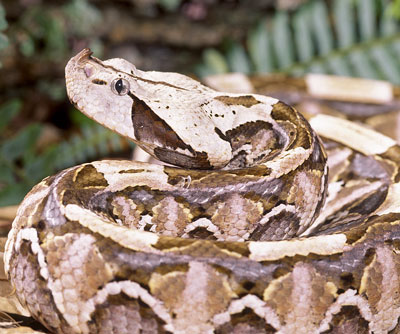
Gaboon Vipers are a poisonous Viper species that we can find in the savannas and rainforests of Africa’s Sub Saharan regions. It is the largest member of the genus Bitis. It is also the world’s heaviest viper. They also possess the longest fangs of up to 2 inches. They also have the highest Venom yield of all poisonous snakes. Adult snakes attain 122 to 152 centimeters in overall length. The maximum total length can be 205 centimeters. Bites are rare owing to their docile nature. If and when they bite, you should consider it as a medical emergency. Even an average bite from even a small specimen could turn potentially fatal.
Rhinoceros Viper – Bitis Nasicornis
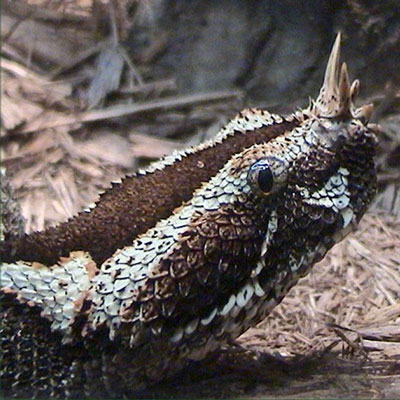
You can usually find the Rhinoceros Vipers in the forests of central and west Africa. This is a big Viper with a striking color pattern and distinct horns on the nose. The viper is large as well as stout. The average overall length is about 72 to 107 centimeters. The Rhinoceros Viper is one of the most dangerous in Africa. Even a very small dose of the snake venom can be deadly.
South American Bushmaster – Lachesis Muta
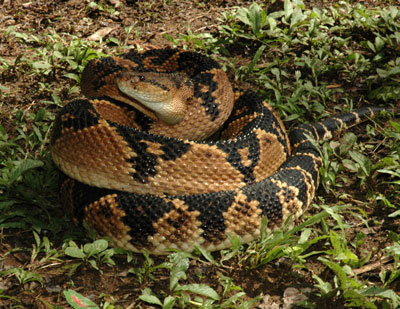
The Bushmaster is a poisonous Viper species you can find in South America and the Trinidad Island. Adults average 2 to 2.5 meters in length. Even 3 meters is not unusual. These species produce a large amount of venom. The potency of the Venom could be weak compared to that of other vipers. This conclusion could be wrong.
Eyelash Viper – Bothriechis Schlegelii
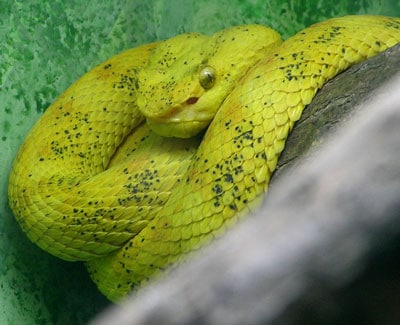
We can find this species of venomous pit viper in central and south America. These snakes are small and arboreal (they spend most of the time high up in the trees) in nature. They have a wide range of color variations. The eyelashes made up of superciliary scales above the eyes are a characteristic of these snakes. They are the most common among green palm pit vipers. They are a comparatively smaller species, with adults ranging in length from 55 to 82 centimeters.
Temple Pit Viper – Tropidolaemus Wagleri
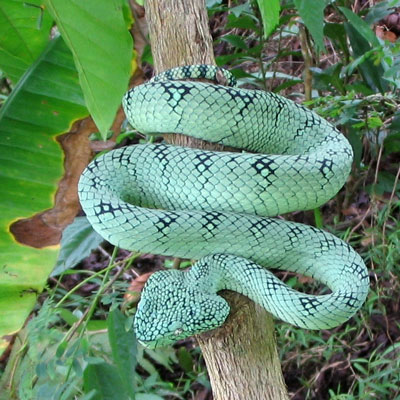
This venomous Pitviper species are native to southeast Asia. The females of the species grow to nearly one meter in length. The males are smaller and they do not exceed 75 centimeters in length. The snakes have large triangular shaped heads. The body is comparatively thin. They are almost arboreal and their prehensile tails aid in climbing.
Mojave Rattlesnake – Crotalus Scutulatus
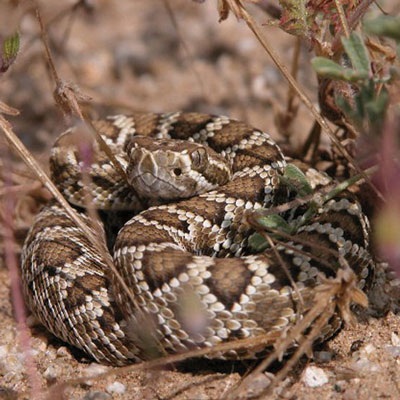
We can find this species of poisonous pit viper in the deserts of South Western United States and Central Mexico. Its venom is highly potent Neurotoxic. The average length is less than 100 centimeters. The maximum length can be 137.3 centimeters.
Pacific Rattlesnake – Crotalus Oreganus
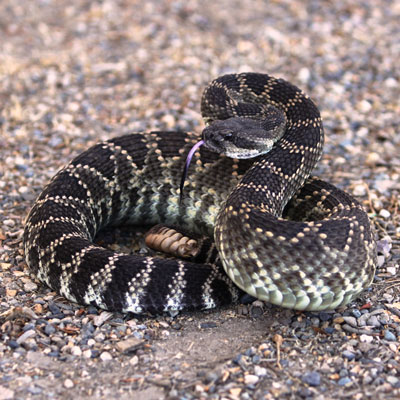
We can find this venomous pit viper species in the Western United States, northwestern Mexico and parts of British Columbia. The variation in the size of the species is of a high order. Some populations are stunted while others grow very large. Mainland species frequently reach 100 centimeters. The largest on record is 162.6 centimeters.

Having discovered a fondness for insects while pursuing her degree in Biology, Randi Jones was quite bugged to know that people usually dismissed these little creatures as “creepy-crawlies”.

